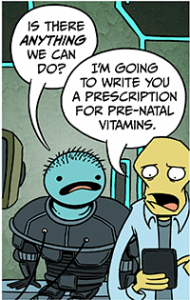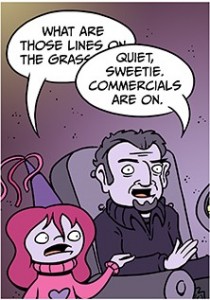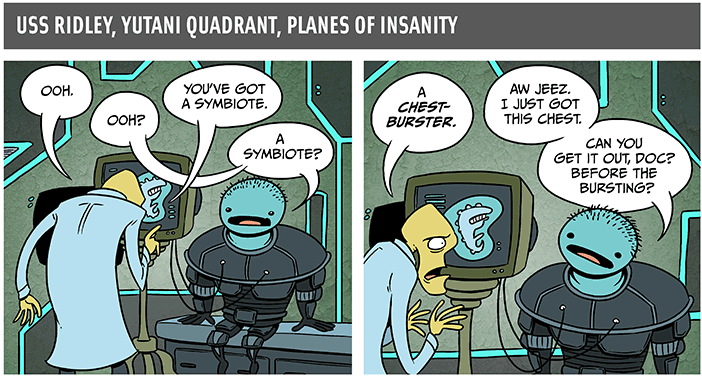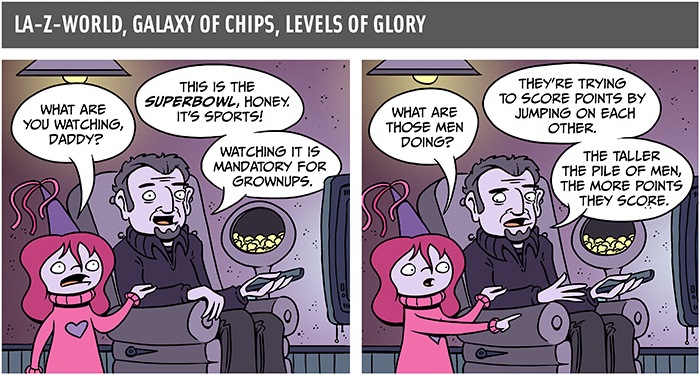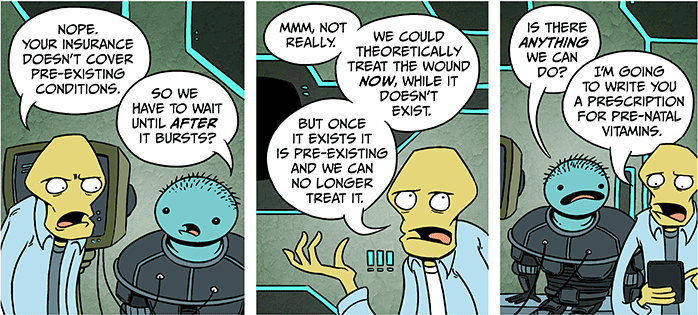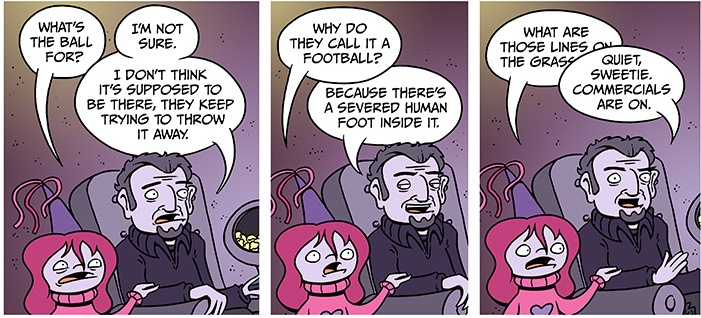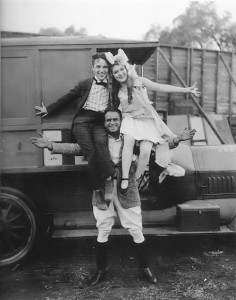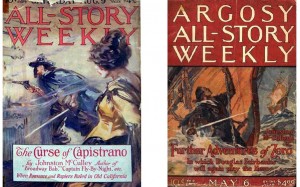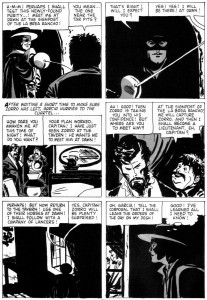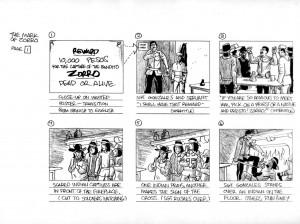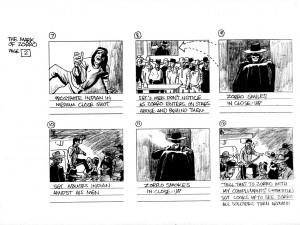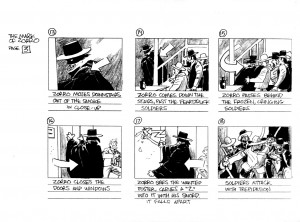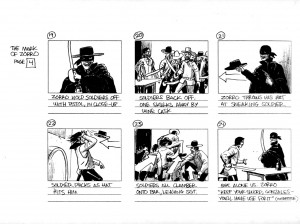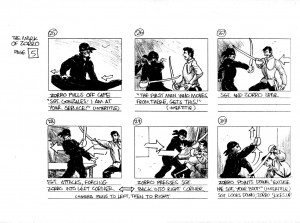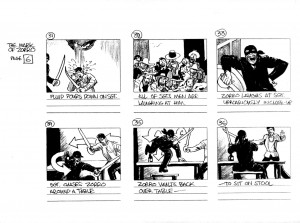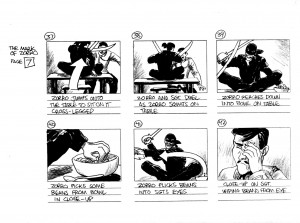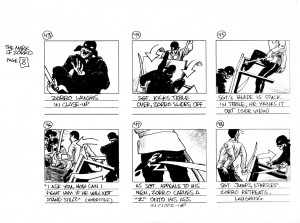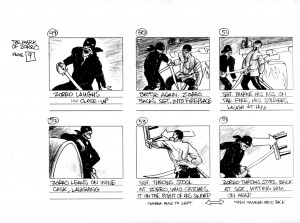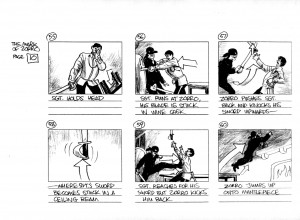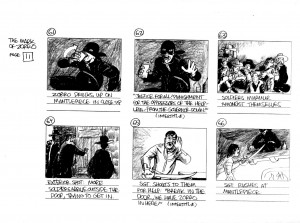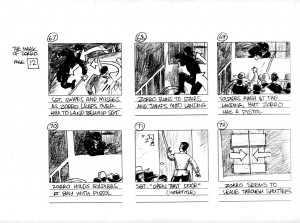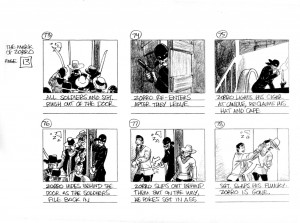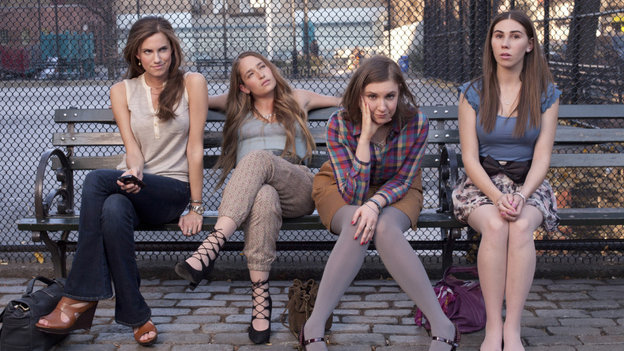What do you want to be when you group up? My daughter, like lots of teens, has been fielding that question since she was two. She’s looking at colleges now, so the question has morphed into “What do you want to major in?” But she told me that her answer, her secret answer, the heart of hearts answer she’ll never write on any application form, hasn’t changed since she wore big girl pull-ups:
“Batman.”
That’s still the first word that pops into her head. “Astronaut” is the second. But Batman is better. “He doesn’t have X-ray vision or any other crazy powers,” she says, “but he still spends his life and money helping people.” Also the Batmobile is really cool. And his ears. My daughter has always thought the bat ears on his hood were cute. She used to chew on them. The dolls in our attic have her teeth marks.
Several graduate and undergraduate programs in comic book studies have popped up since she stopped hosting tea parties with action figures, but to the best of my knowledge, no school offers a major in Batman. Not even mine. We live a five-minute stroll from campus, so my daughter would rather blast off to an alien planet than stay in our Virginia smallville for college. Her brother is still in middle school, and still peruses the occasional comic book from my childhood trove. He’s gnawed on his fair share of attic superheroes, but I suspect he’ll be feeling the warmth of alien suns soon too.
Which means neither will get to take my Superheroes course. I’m teaching it for the fifth time this spring. It spawned back in 2008 when a group of honor students were scouring campus for a professor willing to design and teach a seminar on superheroes. They’d suffered a few rounds of blank stares and grinning rejections when they wandered into my wife’s office. She was chairing our English department at the time, and you’ll never guess whose office she sent them to next. I said yes. Of course I said yes. I’d always enjoyed comics as a kid and then with our own kids. Now I’d just augment that with a bit of research.
My wife doesn’t regret her choice, but neither of us predicted the black hole-sized obsession the topic would open in me. Conference panels, print symposiums, international journals, radio interviews, cybercasts, newspaper op-eds, lit mags, one-act festivals, my appetite for cape-and-mask forums keeps expanding. When my wife and another good friend spurred me to start a blog, neither had superheroes in mind then either. I could blame those meddling honors students, but that first class of sidekicks flew off to solo adventures years ago. I’m the one who keeps offering revised versions of the course every year while posting blog links on campus notices once a week.
The first day of ENG 255 usually begins with some polite but bemused variation on “Why superheroes, Professor?” Colleagues ask me the same, only with the preface “Don’t take this the wrong way but.” The short answer is easy. Superheroes, like most of our pop culture productions, reflect who we are. And since superheroes have been flying for decades, they document our evolution too. On the surface of their unitards, they’re just pleasantly absurd wish-fulfillments. But our nation’s history of obsessions broils just under those tights: sexuality, violence, prejudice, politics, our most nightmarish fears, our most utopian aspirations, it’s all swirling in there. But you have to get up close. You have to be willing to wrestle a bit. I think we should pull on Superman’s cape. I think we all need to sink our teeth into Batman’s head.
Spring registration at Washington & Lee University starts soon. I have yet to work visiting superhero poet Tim Seibles into the schedule yet, but for interested students and the occasional scholar who’s asked me for a copy, here’s the syllabus-in-progress:
ENGL 255: Superheroes
The course will explore the early development of the superhero character and narrative form, focusing on pulp literature texts published before the first appearance of Superman in 1938. The cultural context, including Nietzsche’s Ubermensch philosophy and the eugenics movement, will also be central. The second half of the course will be devoted to the evolution of the superhero in fiction, comic books, and film, from 1938 to the present. Students will read, analyze, and interpret literary and cultural texts to produce their own analytical and creative works.
Texts:
The Scarlet Pimpernel, Baroness Orczy
The Adventures of Jimmie Dale, Frank L. Packard
Gladiator, Philip Wylie
Superman Chronicles, Vol. 1, Jerry Siegel, Joe Shuster
Batman Chronicles, Vol. 1, Bob Kane, Bill Finger
Wonder Woman: The Greatest Stories Ever Told
Marvel Firsts: 1960s
Soon I Will Be Invincible, Austin Grossman
Missing You, Metropolis, Garry Jackson
Additional texts:
Spring-Heeled Jack, Anonymous
(excerpt from) Thus Spoke Zarathustra, Frederick Nietzsche
“The Revolutionist’s Handbook,” George Barnard Shaw
(excerpt from) Tarzan of the Apes, Edgar Rice Burroughs
(excerpt from) A Civic Biology Presented in Problems, George Hunter
“The Reign of the Superman,” Jerry Siegel
(excerpt from) The Clansman, Thomas Dixon, Jr.
“A Retrieved Reformation,” O. Henry
(excerpt from) The Curse of Capistrano, Johnston McCulley
“The Girl from Mars,” Jack Williamson and Miles J. Breuer
(excerpt from) Alias the Night Wind,
“Don’t Laugh at the Comics” (1940), William Moulton Marston
“The Sad Case of the Funnies” (1941), James Frank Vlamos
“Why 100,000 Americans Read Comics” (1943), William Moulton Marston
(excerpt from) Love and Death: A Study in Censorship (1949), Gershon Legman
Comics Code Authority Guidelines
“Secret Skin: An essay in unitard theory” (2008), Michael Chabon
VQR Spring 2008 Superhero Stories
Films:
The Mark of Zorro (1920)
The Scarlet Pimpernel (1934)
The Gladiator (1938)
Look, Up in the Sky! The Amazing Story of Superman (2006)
Comic Book Superheroes Unmasked (2003)
Unbreakable (2000)
Hancock (2008)
Dr. Horrible’s Sing-Along Blog (2008)
Radio:
The Shadow, The Blue Beetle
Writing Assignments:
1. Two 4-page analytical essays examining assigned texts on topics of your design.
2. A 6-page essay combining creative and analytical writing. You will invent superheroes and discuss the characters’ relationships to the history of the genre, responding to specific literary and cultural elements of the evolving formula.
Week One
Mon
*early afternoon film: Look, Up in the Sky! The Amazing Story of Superman (2006)
Tues Superman Chronicles; “Don’t Laugh at the Comics”
Wed eugenics chronology; Nietzsche Zarathustra (excerpt); Shaw Handbook (excerpt); Tarzan (excerpt); Civic Biology (excerpt); “The Reign of the Superman”; Nazi response to Superman; selected historical newspaper article
Thurs Spring-Heeled Jack; The Scarlet Pimpernel (chapters 1-14);
Fri Scarlet Pimpernel (complete); The Clansman (excerpt);
*early afternoon essay conferences
Week Two
Mon rough draft of 4-page essay due
Radio serial: The Shadow
* optional paper conferences after class
Tues Jimmie Dale (Chapters 1, 2, ?, 11, and one additional story); “A Retrieved Reformation”;
“Murder by Proxy”
* early afternoon film: The Scarlet Pimpernel (1934)
Wed final draft of essay due; The Curse of Capistrano (excerpt)
Early morning film: The Mark of Zorro (1920)
Thurs Gladiator (Chapters 1-11); “The Girl from Mars”
Fri Gladiator (complete); Alias the Night Wind (excerpt)
* early afternoon film: The Gladiator (1938)
Week Three
Mon Batman; “The Sad Case of the Funnies” (1941); “The Shadowy Origins of Batman”
Radio serial: Blue Beetle
Tues rough draft of 4-page essay due
*early afternoon film: Hancock (2008); begin superhero project
Wed NO CLASS; individual essay conferences
Thurs final draft of essay due; “Secret Skin”
morning film: Comic Book Superheroes Unmasked (2003)
Fri Wonder Woman; “Why 100,000 Americans Read Comics” (1943)
Week Four
Mon Marvel Firsts (selections); Comics Code; preliminary draft of superhero
*early afternoon film: Unbreakable (2000)
Tues Soon I Will Be Invincible (Part One, to p. 153) [BEGIN CLASS AT 9:00]**
*7:00 Austin Grossman reading, Northen Auditorium
Wed Soon I Will Be Invincible (complete)
Austin Grossman class visit
presentations of superheroes
*early afternoon conferences
Thurs VQR Spring 2008 Superhero Stories
presentations of superheroes
Fri Missing You, Metropolis
presentations of superheroes
* Superhero poster exhibition at the library during the Spring Term Festival from 12-3
Sat Final draft of project due 12:00 at my office
This post is the first in a series on how comics artists represent talk in comics. I’ll be writing about speech balloons and how the discipline of conversation analysis (CA) helps us understand how creative these artists can be when they try to show the intricacies of everyday talk. Consider the following two panels. These are from the webcomic Scenes from a Multiverse by Jon Rosenberg. (Click on each of the titles to see the full comic.) Both of these are the final panel in the comic. Specifically, each one is panel 5 of a 5 panel comic. Understanding the speech and the speech balloons in these two panels will depend on the sequencing of balloons in previous panels and, to some extent, the social context of the conversation. In most kinds of comics, speech balloons show conversations in relatively uncontroversial ways. In smaller panels, there may be one, two, or three characters producing speech, while larger panels and full-page panels may contain a dozen or more characters talking at the same time. In conversation analysis (CA), the approach to studying talk is to keep track of the number of turns, how long the turns are, how many speakers there are, and how much silence there is, among others. This post is the first in a series about speech balloons and conversation sequence. In particular, I will focus on how comics artists draw two or more characters talking at the same time. When two or more speakers produce speech at exactly the same time, then this is called simultaneous talk. (Sometimes it is called interruption, and sometimes it is overlap, but this depends on interpretation.) When listening to conversations, it is relatively easy to identify moments when participants are talking ‘on top of each other.’ And in transcribing the speech, there is a small set of typographical symbols that scholars typically use to do this. Consider the following excerpt, taken from an article by Emanuel Schegloff (2000) on simultaneous talk (p. 26). The two speakers, Anne and Dick, are an elderly couple who have been married for a long time. In this short excerpt, we see a good bit of simultaneous talk. Anne and Dick are having a conversation with their daughter, and it takes a funny turn in that Dick gives Anne a hard time about spending money on shoes and her claim about how many pairs of shoes she owned. SOURCE: Schegloff, E. (2000). Overlapping talk and the organization of turn-taking for conversation. Language in Society, 29 (1): 1–63. Lines 52 and 53 are clear examples. According to this transcription, at exactly the same time that Dick begins the word ‘six,’ Anne begins her utterance with ‘WHY’. The effect is that while Dick already has the conversational floor, Anne joins in, and the listeners have to keep track of what both of them are saying. At the end of Dick’s word ‘shoes’, he stops speaking but Anne continues her turn through line 54. The use of all capital letters indicates that Anne is using a LOUD volume. It’s one thing to listen to speech and write it down in a transcription. But in comics, it seems to me that it’s a creative challenge to represent simultaneous speech using speech balloons. In other words, how does an artist use visual cues (putting one balloon on top of another) to signal a certain kind of verbal cue (two or more speakers talking at the same time)? The question I have is whether the visual difference in the balloons has a material impact on the way readers ‘hear’ the speech. Does the doctor’s turn ‘sound the same’ as the dad’s turn? If there is a difference, is it a difference of kind or a difference of degree? To answer the questions, we should examine each of the comics in terms of conversation and speech balloons. The Symbiote The first two panels of ‘The Symbiote’ show very traditional strategies for representing turns and turn-taking. The doctor in panel 1 begins the sequence, with the patient taking the second turn, and the two trading off in panel 2 as well. Even though the tails cross in panel 1, I think readers would perceive these turns as more or less separate, perhaps with no simultaneous speech at all. In panel 2, the visual separation of the balloons is even clearer, indicating that the two speakers are being careful to take turns without ‘stepping on each other’s toes.’ The Superbowl (sic) In panels 1 and 2 of ‘The Superbowl,’ the speech turns proceed much like those in ‘The Symbiote.’ I think the visual separation of speech turns here is crisp, with the tails of the balloons never crossing. The content of the balloons indicates that the daughter takes the first turn by asking a question and the dad takes the second turn by answering the question. This is true for both panels. If we consider the sequence of panels 3-4-5 in both comics, we may be able to discern more readily whether the speech in the final panels are indeed different kinds of simultaneous speech. In both comics, panel three is composed very similarly. The speech balloons of speakers 1 and 2 are touching, and in fact the balloon of speaker 2 is ever so slightly overlaid onto the balloon of speaker 1. Panel 4 in ‘The Symbiote’ has just one speaker, the doctor, but Panel 4 in ‘The Superbowl’ shows the two speakers producing some measure of simultaneous talk. As we saw at the beginning of this post, panel 5 for both comics shows that one balloon is overlaid on top of the other. It is more than likely that readers are supposed to ‘hear’ simultaneous talk. In other words, the doctor talks at the same time as the patient, and the dad talks at the same time as the daughter. What interests me about them is that in both panels, one speech balloon overlaps the other. There are some slight differences, however. In ‘The Symbiote,’ the doctor’s speech balloon overlaps the patient’s speech balloon, but all the words are visible. On the other hand, in ‘The Superbowl,’ the dad’s balloon overlaps the daughter’s but also partially obscures two words (on and grass). What is not clear is whether the balloon obscures additional words or other symbols in the balloon, symbols like ellipses (…). But is the amount of simultaneous talk the same? If we hear the panels differently, what elements of each comic are we meant to consider when we decide how they sound? When you read these two comics, how do you ‘hear’ the turns playing out? What might Rosenberg be trying to accomplish by drawing one speech balloon on top of another? How much does the turn-taking sequence affect our perception of the balloons? And how much of an impact does the social context or the identity of the speakers have? In part 2 of this series, I’ll talk about simultaneous discourse in Grant Morrison’s The Invisibles. In 2011, inspired by Twitter, graphic novelist Renae de Liz turned to Kickstarter to seek funding for an all-female comics anthology. Womanthology: Heroic triumphed, surpassing its original funding goal within 24 hours. De Liz sought to unite a large number of women, from comic book veterans to complete unknowns, to create “something fun and positive,” hoping that the book would inspire and empower burgeoning cartoonists. Though some criticized the project’s execution, most celebrated Womanthology’s central premise: that women should be provided with a platform for publication in an industry where they have been (and continue to be) marginalized. As IDW editor Mariah Huehner said, “[The issue of women in comics] always seems like this problem that people want to solve.” People hoping for a quick or easy solution are out of luck. Cartoonist-turned-comics-“herstorian” Trina Robbins notes in Pretty in Ink (2013) that while women have been drawing and writing comics in the U.S. since 1896, they have historically been a minority in the field. Today, sites like Bleeding Cool regularly “gendercrunch” the rosters of Marvel and DC Comics, and the numbers regularly fail to approach gender parity. A 2012 Ladydrawers comic by Anne Elizabeth Moore and Nicole Boyett notes that “even though they’re submitting work at rates equal to men and make up 46% of the creator pool, women, trans and non-binary gender creators are getting much less of it published.” This overt overlooking of non-male creators holds true for comics criticism, too, as Heidi MacDonald pointed out in her recent critique of The Comics Journal. And yet, for as long as there’s been an American “comic-books boys’ club,” women have demanded they be admitted. Some, like de Liz, have tried to open the gates for others. At The Millions, Andrew Rostan writes of Womanthology: “There is little doubt that all 300 artists were working with an ideal audience in mind — themselves in their youth — working to forge another generation of female creators.” De Liz herself observed, “People probably label this a feminist book just because it’s a bunch of women are gathering [sic] in one spot. I don’t really mind if they do or not; feminism isn’t a dirty word.” De Liz is right to link her project to the American feminist movement. Womanthology owes a huge debt to comics borne of nascent second-wave feminism and the burgeoning underground comix movement: It Ain’t Me Babe Comix (1969), the first American comic book created entirely by women, and Wimmen’s Comix (1972- 1993), a long-standing all-female underground comix anthology, which made a point of perpetually including new contributors. (It’s worth noting that Womanthology, It Ain’t Me Babe, and Wimmen’s Comix share an influential contributor –Trina Robbins.) Of these titles and others, sociologist Paul Lopes writes, “This first generation of female comic book rebels unquestionably laid the groundwork for future generations of women artists to intervene and attempt to transform the field of comic books.” Sound familiar? In the late ‘60s, mainstream comic publishers were in free fall, sapped of their strength in part by the incredibly restrictive 1954 Comics Code Authority, which led to the untimely demise of many comics publishers. As the ‘60s gave way to the ‘70s, a new kind of comic book began to emerge. The underground comix movement of the late 1960s changed the comic field for everyone, but it was of particular importance in integrating women into a highly gender-imbalanced industry. (As Robbins notes, by 1974, at the tail end of the underground comix heyday, only two women remained at mainstream comics publishers.) To put it another way, the underground was like the internet: both offered new mechanisms for the production and distribution of comics, and allowed new creators (female and male) a chance to try their hand at the form. Wimmen’s Comix, like Womanthology, offered a platform for publication for artists who had never considered careers in comics (as well as many who subsequently failed to pursue such careers), featuring roughly 100 contributors over its 20-odd-year run. Wimmen’s Comix, though seminal, was not necessarily a financial success. Along with other early underground comix by women, it is long out of print (though still for sale on EBay). It’s reasonable to expect that many supporters of or contributors to Womanthology have never seen a copy of Wimmen’s Comix, as it has not yet been collected in its entirety. This is, in fact, part of the issue of women in comics. The work of forging future generations is not difficult for lack of raw material. It is difficult, at least in part, because the work of generations gone by is often lost or hidden, to the detriment of those who would otherwise seek to learn from it. Much has changed between It Ain’t Me Babe Comix and Womanthology. (Alternative spellings of “women” and “comics” have largely fallen out of style, for one.) And yet modern attempts to solve the “women in comics” problem resemble nothing so much as older strategies, including those of Wimmen’s Comix, that some now deride as passé. Given that publishers and critics can more easily detect Wonder Woman’s plane than female comics creators, a project like Womanthology, capable of catching the comics gatekeepers with their guard down, seems like a strategic success. Certainly self-publishing, whether it’s a webcomic or a Xeroxed mini, ensures that women’s work gets printed. De Liz’s project further clearly demonstrated the commercial viability of anthologies like Womanthology. In 2012, IDW Publishing announced a five-issue comic book series titled Womanthology: Space!, collected as a hard-cover graphic novel in 2013. Still, many will argue (or have argued) that women’s-only projects like Womanthology put women at a disadvantage. Comics blogger Rachel Fellman writes of Womanthology, “When I was a teenager, nothing discouraged me more than projects that made a point of supporting women’s artistic efforts. They reinforced the idea that it was an exception for women to make art — and that we needed special help because we rarely did it as well as men.” The fear that publishers may “make up for a lack of general diversity with occasional, themed anthologies,” as Greg Baldin put it at the Los Angeles Review of Books, is real. A single anthology, no matter how many artists it includes, can’t solve a systemic problem. Solving the issue of women in comics is problematic, to say the least. An equally daunting challenge is to pay proper homage to the heroines and heroes who have sought change. In this and future columns, I will focus on the work of female-identified creators in a particular period of comics history (roughly 1968-1990), to better detail what exactly the problem has been, in the hopes that it will illuminate what it is today. Tongue in cheek, a few of my friends will wonder aloud how I can be so very obsessed with Disney if I’m a feminist. Wink, nudge. Though these jokes are, well, jokes, they hint at common cultural understandings of Disney’s relationship to women and feminism. Comments that I’ve heard imply that being a feminist can, somehow, be quantitatively determined by one’s hobbies and likes and, once graphed on some X-Y axis or other, that feminism is negatively correlated with an appreciation for Disney movies. Similarly, some Disney princesses are seen as more or less feminist by virtue of their hobbies. Merida from Brave is a feminist because she doesn’t care for marriage and likes archery, but Ariel, from The Little Mermaid, isn’t a feminist icon because, well, she obsesses/lusts/romances over a prince and surrenders her voice in an attempt to win him over. However, this reading of Ariel is too easy, too clear, an analysis that lacks the messiness that comes hand-in-hand with desire and obsession. Strangely, however, instead of rigorous feminists accusing Disney of this mish-mash of oppression, the protests against Disney show up on my Facebook feed from casual allies, non-feminist men, brogressives, and teenagers engaged in various sub-cultures. Protesting Disney is no longer the foray of feminists who, in any case, have been long-time fans of complicating narratives, a tradition in which I am happily cemented. Just as male comic book nerds protest the antiquated gender roles in Twilight, so too have these groups accused Disney of not following some make-believe feminist handbook. I’m left hearing sarcastic comments or well-meaning comments, both annoying, that caricaturize the meaning of strength and reconstitute feminism as a rigid set of rules instead of an analytical category with emancipatory possibilities. What of Virigina Woolf, who declared that “a feminist is any woman who is honest about her life?” I’m not interested in rescuing Disney from its errors—of which there are many—but I am interested in complicating dominant narratives surrounding Disney heroines and how our very rejection of romance, a rejection based on a belief that Strong Women just don’t do this and that and they especially don’t obsess over boys, is a form of reifying traditional gender norms. Not only does rejecting infatuation create social problems (goodbye, teenage girls, your problems matter no more), but the existence of uncontroversial female characters who don’t make mistakes, experiment with love, and aren’t obnoxiously demanding risks veering into Mary Sue territory. In Frozen, Disney avoids controversy by constructing a plot where good people react to situations beyond their control. In The Little Mermaid, Ariel is an active participant in her own plot; she makes mistakes that she then tries to fix, or makes decisions that the audience finds disagreeable but that she defiantly claims for herself. In fact, Ariel’s entire character is marked by defiance and resistance, making her a more compelling but polarizing character. I enjoyed Frozen, as I was instructed to enjoy the film—I couldn’t help but feel like the film was green-lit with the approval of a focus group consisting entirely of my clones. But as I watched the film, I shifted uneasily in my seat because, though Disney had created a story focusing on sisterly love instead of the usual male-female romance, the plot was underdeveloped because the main character, Anna, was written as a parent-approved role model. The desire to avoid the criticisms that have usually stalked Disney princesses suffocated Frozen like a pageant parent who scrubs her child clean and only allows her to perform in ways approved by the judge. The result is a delightful movie, a movie that we expect. But is creating a clean-cut and uncontroversial character a sign of progress? Disney’s Frozen was a film that was self-aware of its legacy, as illustrated by the song “Love is an Open Door,” where Anna falls in love and becomes engaged to Prince Hans in the course of a 3 minute song-montage on the night of her sister’s coronation. Like many contemporary young adult films and books, an inevitable love triangle occurs once Anna leaves the castle in search for her sister and befriends Kristoff. He asks her, in absolute disbelief, how she could become engaged after knowing someone for one day. (And he also insists that all men pick their noses and eat their boogers, a statement which I refuse to empirically verify.) Anna retorts that it’s true love, duh. Disney engages in some fun inter-textual analysis where it pokes at its own films. Historically, their films have featured heroines that have hopscotched into a life of happily-ever-after once the obligatory two-second kiss has been bestowed by a prince whose name the audience doesn’t even know. Instead of focusing on the love triangle, however, Frozen is a story about sisterly love, though still featuring the theme of sacrifice commonly found within Disney. Its strength lies in its characters grappling with notions of responsibility and learning what love truly means. However, despite its excellent passing of the Bechdel test, Frozen has a number of problems with plot. Here I grated my teeth. Because I was supposed to fall in love with Frozen and I kind of did—finally, a Disney film that could meet my feminist credentials. Except, as a wannabe storyteller, I could see the problems caused by trying to keep Anna controversy-free and within the box of “appropriate role model.” Frozen’s plot seems to advance through convenience instead of character agency. Ariel must choose between her obsession and her family, a decision which infuriates casual Disney watchers—how could she choose a boy over her family? How could she give up her voice for a man? But Anna isn’t required to make this decision. Instead of Anna rejecting Hans, admitting that she may have made a mistake, Hans is conveniently revealed to be a Bad Guy who used Anna as a way of becoming king. This plot-twist is also familiar, though Disney seems to have gender-bent the trope. Margaret Atwood once remarked that Victorian love-triangles often featured ailing wives dying conveniently so that the path would be made clear for the heroine and the dark, brooding hero to get married without facing the prospect of actually divorcing, a decision which would remove sympathy from the male lead. Anna’s good-heartedness is solidified when she is omitted from having to make this difficult decision; if Hans had been good and she had broken off the engagement then she becomes too complex, too authoritative, too unsympathetic. In a sense, Frozen features characters that are the victim of circumstance rather than their own choices, a writing mechanism which shields them from the controversies that have plagued other princesses who have made questionable decisions. Anna discovers the true nature of love by saving her sister, a type of selfless love that is above criticism but a role that girls and women have traditionally been expected to fulfill anyway. Anna’s life is never seriously in danger, of course, (and not because Disney is the creator—the studio has made a number of darker films) and so the question of her sacrifice, plot-wise, is compromised. Discovering the meaning of selfless love is an important part of human development, but a theme that would have been sharply criticized had Anna sacrificed herself for Kristoff instead of Elsa—a claim that I cannot prove empirically, but which I feel confident in asserting upon observing how we treat teenage girls trying to understand their sexuality –poorly. Despite Anna being distinctively cute, Frozen is relatively free of sexual desire minus short bursts of puppy love and infatuation with Hans, which are shown to be a Big Mistake when Hans reveals his duplicitous nature. In the end, Anna faces a choice; be rescued by true love’s kiss (from Kristoff) or sacrifice herself to save Elsa. She chooses the latter. Disney’s The Little Mermaid is an undeniably darker story, though the original story by Hans Christian Anderson is even more bleak. Whereas Anna and Kristoff share a bumbling and endearing kiss at the end of the film, Ariel spends much of The Little Mermaid lusting after Prince Eric’s body. She wants to be human, wants their legs, to know what it feels like to walk. Eric is a prince, but he’s also a body that is imbued with symbolism—he’s not only Eric, but a representation of everything she wants. She gushes over him, and once she saves Eric from the peril of the sea and returns him to land, pauses to admire him, leaving no question that her crush is based on sexual desire. It’s this sexual desire that makes Ariel a controversial character. Though Ariel is often condemned for leaving her family for “a boy,” she is, to me, a more interesting character because she made a difficult decision with moral consequences that cannot be waved away with a magic wand. It is precisely Ariel’s aggression, stubbornness, and ability to carve out her own plot by making questionable decisions that leaves a lasting impact. The permanence of her decision makes Ariel’s sacrifice more impactful than Anna’s sacrifice, the latter whose decision we know will have no lasting consequence because love will act as a magical healer and “save the day.” Ariel’s decision to marry Eric, however, isn’t heroic—heroism is selfless, and her desire to marry Eric is tainted by the fact that she’s doing something for herself. In the real world, she might be called selfish or a bitch. She crushes hard on a human prince, has a hoardish obsession with collecting human artifacts, and eventually exchanges her voice for a pair of human legs so she can pursue Prince Eric and, if he falls in love with her in the requisite time period, will remain human forever. These human legs come at the cost of engaging with Urusula the Sea-Witch—but only after her father, King Triton, discovers her cave of human objects and destroys all that she loves, objects which are the source of her knowledge and curiosity. This tough-love disciplinary approach is for her own good—an argument as novel as the Old Testament when Adam and Eve were tossed out of the Garden because Eve just had to taste the fruit from the Tree of Knowledge. Ariel becomes Eve, obsessing over artifacts that promise to unfold secrets but with the potential to unbridle her sexuality. Eventually, her decision to give up her voice for a pair of legs is shown to be a mistake, because post-1990 Disney films always comes with the “be yourself” moral message. However, the film is perfectly clear that her father was also mistaken to control her. Some audiences remember the former message, but not the latter. I am still surprised when people condemn Ariel, especially when her father is the one who believes that her desire for human knowledge is a source of harm and whose destruction of her possessions drives her into the arms of Ursula the Sea Witch, a character who functions as some kind of fat woman quasi-capitalist obsessed with creating unfair contracts in hopes of usurping the monarchy and the “rightful” king—she’s worthy of admiration, really. Ariel is the prototypical Bad Woman, removed from the roster of Acceptable Feminist Heroines (by those who parody feminism?) because she has sacrificed her family for self-fulfillment. We’re condemning Ariel for her disobedience. In the end, her father realizes that it’s unfair to prevent Ariel from being happy and, with his magical trident, grants her legs. The reconciliation between Ariel and her family mirrors the ending of Bend it Like Beckham, but the latter is situated as a British “girl power” movie because the main character wants to play soccer, a goal that is valued more than romance in the hierarchy of fictitious Approved Feminist Activities. (And because the main character of Bend it Like Beckham is brown, and we’re more comfortable seeing brown daughters rebel against their fathers because our own orientalist inclinations lead us to view their family structures as innately oppressive—but girls rebelling against white men? Well, that just won’t do.) My conclusion is fairly trite and I don’t mind admitting it; imperfect characters make for compelling stories. Restraining ourselves and making characters that shy away from controversy can actually reaffirm the gendered expectations that we’re trying to avoid. Often, what we do not question, such as selfless love for family, is steeped in normativity. Allow teenage girls the agency and the opportunity to make mistakes, to lust. Stories can do many things, and at the very least we should, on occasion, be challenged. Stories also deserve our criticism, of course, but they deserve levelled, thoughtful, and nuanced criticism that does not unintentionally reproduce a hierarchy of values that only congratulates selflessness and condemns self-fulfillment. Silent film star Douglas Fairbanks (1883-1939) was hugely popular in his time. He was one of the first performers of whom it could be said that he was less an actor than a star who was considered to be “playing himself.” He was so universally recognized and his audiences’ expectations were so great that in his films, his actual name would come up on the intertitles as he was introduced onscreen. The first part of his career was spent making vigorous comedies full of antic chase scenes, such as His Picture in the Papers, Manhattan Madness and His Majesty, the American, all of which blended his facility for comedic timing with great acrobatic skills. He became the quintessential boys’ hero. United Artists: Chaplin, Pickford and Fairbanks By the time of his formation of United Artists with the even more popular stars, his wife Mary Pickford, Charlie Chaplin and D.W. Griffith, Fairbanks had come to retain considerable control over his movies. He produced, wrote and starred in his own films and was in a position to select his casts and crews from the best talents Hollywood had to offer. With his 30th film, The Mark of Zorro, he initiated the action genre in film. Thereafter, he dedicated the remainder of his career to the costumed adventure genre. He set a source precedent for all of the action stars to follow such as Errol Flynn, Burt Lancaster and the nameless protagonist of the My Name is Nobody spaghetti westerns, as well as even the semi-humorous performances of musical star Gene Kelly—and influencing contemporary stars of action/comedy like Jackie Chan, Arnold Schwarzenegger, Bruce Willis, Johnny Depp and “The Rock.” Fairbanks’ 1920 silent feature film version of The Mark of Zorro derived from the prose serial adventure “The Curse of Capistrano” by Johnston McCulley that ran in six parts in the pulp periodical All-Story Weekly in 1919. Fairbanks’ son Douglas Fairbanks Jr. in his autobiography says that McCulley’s story was brought to his father’s attention by agent Ruth Allen, who was a friend of Anna Sully, his mother and Fairbanks’ first wife. Fairbanks initially was reluctant to diverge from his modernist comedic image to do a period piece, but eventually he was convinced and procured the option. The resulting film became so popular that it determined the trajectory of his future career: (The Mark of Zorro was) by far the most successful movie he ever made…a more than minor classic of its kind, widely imitated and remade…the phenomenal success of Zorro convinced my father from there on to take more time and concentrate on producing a series of high-quality, expensive films that would be exhibited first for long runs in regular theaters (not movie houses) with reserved hard-ticket seats (Fairbanks Jr. 64). The exclusivity implied in this type of limited engagement and the increasingly impressive budgets Fairbanks commanded for his productions served to elevate the formerly crass medium of movies into something more resembling an art form. Although, a factor in Fairbanks’ decision to make The Mark of Zorro was a consideration of economy: the events of the film, set in Spanish California at the end of the previous century, were placed in the same location as Fairbanks’ studio in the southern part of the state, which was tremendously convenient and served to keep costs down. The Mark of Zorro was directed by Fred Niblo, who would also helm Fairbanks’ next adventure film The Three Musketeers, but as was typical for the star, he wrote the film scenario and took a firm hand in all aspects of the production. In his auteuristic capacity, Fairbanks took the initiative to deviate from his pulp source and alter certain story points to telling affect. Significantly, he added several tropes to the original source story that would be credited as the inspiration for Batman and other popular cultural vigilante heroes. However, while Fairbanks’ Zorro is certainly one of the prototypes for the dark masked hero with a ubiquitous identifying symbol intended to strike fear into the hearts of evildoers (i.e. Zorro’s slashed “Z,” Batman’s “bat signal” and The Phantom’s skull ring, which leaves its impression on the chins of the villains he punches), the earliest precedent for the swordsman vigilante with a symbol and a “foppish” alter ego is Baroness Emma Orczy’s the Scarlet Pimpernel, a hero of adventures set in the Reign of Terror of the French Revolution. The Pimpernel’s other identity is Sir Percy Blakeney and at the scenes of his escapades, he’d leave a calling card on which was printed an image of the flower of his namesake. The character first appeared in book form in 1905 and the character debuted in Hollywood as early as 1917, when a silent feature directed by Richard Stanton and starring Dustin Farnum was released by the Fox Film Corporation. It would seem that Fairbanks took inspiration from the Pimpernel to add the “Z” symbol and to emphasize Zorro’s “effeminate” plainclothes disguise, Don Diego de la Vega. Actually, Don Diego is not Zorro’s true identity, but another smokescreen for a hero who has two false faces. This has been counted as Fairbanks’ innovation by his biographer Jeffrey Vance: “Fairbanks’ exploration of the different natures of masculinity is a source of continuing comment…The Mark of Zorro’s juxtaposition of the effete Don Diego and the vigorous Senor Zorro is the most distinctive delineation…both identities are masks. Don Diego Vega is neither fop nor fox.” Comics scholar Charles Hatfield concurs and further says that the dual deception of Zorro enables the hero to navigate “an ironic class mobility à la so many versions of Robin Hood” and displays a bending of gender expectations to denote a “masculinity…made triumphant, queerly enough, through flamboyance” (Hatfield 113). These descriptions run very much along the lines of Batman’s alter-ego, Bruce Wayne, who lives in a mansion with only his butler Alfred and his teenaged ward Dick Grayson, an arrangement that was decried as “like a wish dream of…homosexuals living together” by psychiatrist Frederick Wertham in his 1954 expose of supposedly degenerate comics, Seduction of the Innocent, which raised such a controversy that public sentiment turned against the comics medium and a congressional inquiry subsequently served to drive many publishers out of business (cited in Williams, 4). Hatfield’s sources include an essay by Catherine Williams that takes the gendering questions that arise from considering these depictions much further. Concentrating on the Tyrone Power remake of The Mark of Zorro but making observations that are also applicable to Fairbanks’ original and his prose source as well, Williams first explicates the phallic symbolism of the ubiquitous swordplay of the Zorro films, then offers: Zorro fights for the aristocracy without their support and, while becoming a folk hero of sorts for the peons, does little to improve their constrained circumstances. It cannot be mere coincidence that Zorro, the flamboyant guerrilla who is outside all political systems, has as his alter ego an openly gay man, an outlaw of sorts himself” (Williams 13). Williams claims that such closeted homosexuality is deliberately used by the powers that be, which then begins to cross over into the non-fictional real world: “(Zorro) isn’t really about a revolution led by a gay man to alleviate the suffering of the poor. Diego/Zorro’s mission, it turns out, is about preserving the line of succession, about maintaining the system’s power to ‘reproduce’ itself” (13). With the long-standing, long-accepted “don’t ask, don’t tell” policies of the American military, Williams asserts, “one can ‘be’ gay as long as one does not pursue gay sex or inform the military of one’s orientation” (14). For superheroes and homosocial institutions such as the military alike, (They) must forego sexual relations in the line of duty while manufacturing a deliberately misleading persona. Thus their ability to serve as warriors is a direct result of a “secret” or closeted identity. What is most terrifying about this link between popular culture and government policy is the way the closet is reinforced as a ‘noble’ or ‘heroic’ institution—something that should be done for the good of the country (Williams 14). Williams thusly links the closeted identities of fictional vigilante and superheroes to the agendas of the very real military-industrial complex, an enveloping conspiracy if ever there was one. But, regardless of these implications and perhaps in ignorance of the earlier Scarlet Pimpernel, Batman’s creators credit Fairbanks and his Diego/Zorro as an influence. Bob Kane co-created the character in 1939 with writer Bill Finger, who said, “My idea was to have Batman be a combination of Douglas Fairbanks, Sherlock Holmes, The Shadow and Doc Savage as well” (Steranko, 44). The creators of Superman, Jerry Siegel and Joe Shuster, also claimed Fairbanks as a prime influence on their character, whose early appearance often depicted him in the star’s signature hands-on-hips stance. In fact, Fairbanks’ amendments to Zorro’s character were also assimilated by author McCulley for his subsequent sequels. Such Fairbanks-initiated devices as Zorro’s slashed “Z” symbol and Diego’s ineffectual “handkerchief illusion”, prefaced by the character saying “Have you seen this one?” turned up in McCulley’s follow-up story in the now-renamed Argosy All-Story Weekly, “the Further Adventures of Zoro” (sic) which as I found, thanks to HU contributor Alex Buchet, was deceptively cover-subtitled with “In which Douglas Fairbanks will again play the Hero” : Left: cover of All-Story Weekly, 1919. Fairbanks did not subsequently adapt that story for his own Zorro sequel, the 1925 Don Q, Son of Zorro— but rather, he appropriated some of its elements for another film property entirely, The Black Pirate. According to Fairbanks scholars John C. Tibbetts and James M. Walsh, Similarities between McCulley’s sequel and the Fairbanks pirate film include scenes wherein the heroine is captured by a pirate ship, the hero scampering about the rigging of a pirate ship, a rescue affected by allies of the hero in a pursuing ship. Even the character of Barbados is echoed somewhat by Donald Crisp’s portrayal of a tough old pirate with a heart of gold. (Tibbetts & Walsh 124). David A. Cook cites Fairbanks as the originator of the adventure spectacle, whose “star personality so influenced the character of his films that he deserves to be called an auteur”, who embodied the “all-American boy—boisterous, optimistic and athletic—who detested weakness, insincerity, and social regimentation in any form” (Cook 222). Additionally, Cook and other film scholars rank Fairbanks among the earliest champions of experimental film color for his use of the expensive two-color “cemented positive” Technicolor process for The Black Pirate. It can’t be overstated just how profoundly Fairbanks set the heroic standard of his time. The star kept himself in extremely good physical condition—apart, that is, from his heavy smoking habit. He was famous for doing his own stunt work and a great part of his preparations for his films was dedicated to making his onscreen physical feats viable. For The Mark of Zorro, he engaged the assistance of stuntman Richard Talmadge. According to Vance, In rehearsals, Talmadge mainly served as a model; Fairbanks, along with his trainer, Lewis Hippe, watched him go through the action in order to eliminate flaws and minimize hazards. Once a stunt routine was effectively refined to Fairbanks’ satisfaction, the star himself executed the feat for the cameras. (…) Invaluable expertise was also provided by a Belgian fencing master, Henry J. Uyttenhove…who choreographed all of the film’s dueling sequences (Vance 96). Douglas Fairbanks Jr. corroborates his father’s stunt-training methodology with an account of the star’s preparation for Don Q: One of the principle gimmicks of this Zorro sequel was the expert cracking of a giant Australian bullwhip. In order to learn how to do tricks with the monster lash, Dad had sent for the famous Australian athlete and bullwhip expert Snowy Baker. It didn’t take long before Dad was able to whirl the long blacksnake, make it crack like a pistol shot, and then snap a cigarette out of a brave and steady mouth fifteen or more feet away (Fairbanks Jr. 104). In this way, Fairbanks used experts to give his stunts a feel of authenticity and won his audience over by displaying what seemed to be incredible feats of physical strength and stamina, in much the same manner as did the earliest incarnations of the “cinema of attractions.” Fairbanks’ subsequent films were all action/adventures with his trademark comedic touch. One of the greatest is certainly The Thief of Bagdad. Fairbanks’ performance in this film is astounding; he seems more like a dancer than an actor as he moves in fluid choreography through sets which are built on a huge, vaulting scale, nearly dwarfing the performers. The climactic scene where Fairbanks attacks a city with a massive magical army that appears in puffs of smoke reminds me of nothing so much as director George Lucas’ first sequel to the Star Wars trilogy, The Phantom Menace. It is strange to think that in 1999 I waited with my son in line for hours to see what I recall mostly as a screen filled with legions of digitally created, exponentially replicated clone warriors that hardly look any more convincing than what Fairbanks was able to create onscreen in 1924. ____________________________________________________________ (Note: as with my other HU posts about film, this is a revised version of an essay originally done as a final paper for a recent class. In this case, I accepted my professor’s challenge to write about Fairbanks and to that end, I proposed to “reverse-engineer” a storyboard for one of the star’s silent films.) For the preparation of the storyboards that follow, I studied the narrative techniques of storyboard artist and legendary cartoonist Alexander Toth. It is coincidental that Toth is not only one of the most exemplary storyboard artists, but also an artist whose career is inextricably linked with the character of Zorro. In fact, Toth’s most famous comic books are his adaptations of the late 1950s, early 1960s Disney TV version of Zorro starring Guy Williams—and those are among the most refined products of the best-selling and family friendly but often relatively bland Dell imprint: Alex Toth, “Zorro: Garcia’s Secret,” Four Color Comics #933, 1958 In his introduction to the reprint collection of his classic Zorro series, Toth wrote, “Fairbanks…created the visual film persona for all later renditions of Zorro to imitate.” However, Toth claimed to prefer the 1940 remake of The Mark of Zorro, directed by Rouben Mamoulian and starring Tyrone Power. Of Fairbanks’ original The Mark of Zorro, Toth recalled, “I did see this silent classic at NYC’s Museum of Modern Art film seminar series in the 1940s and enjoyed its zesty, witty gymnastics, but the film’s dated style pales in contrast to Mamoulian’s ageless 1940 epic” (Toth 11). Despite this disclaimer, Toth’s Dell comics depictions of Zorro often echo the feel of Fairbanks’ version of the characters and settings equally as much as Powers’ update. The storyboard is my fabrication to make a point. Fairbanks was unusual in that he not only produced and starred in his own films and did his own stunt work, but he wrote them as well. Though almost all films did eventually came to be done from scripts, in actuality the early silent films were rarely if ever scripted. Fairbanks was known to work from a relatively loose scenario, which left a good amount of leeway for improvisation in the filmmaking process. His films and indeed, all silent films were likely never storyboarded. Storyboards first were used by the Walt Disney studio for a 1933 short, Three Little Pigs—and the first live action feature to be entirely storyboarded was the 1939 Gone with the Wind. But, Fairbanks is the founder of the action film, a genre that at the present time provides the bulk of storyboard artists’ employment, as action sequences are where their skills are most needed and in the most demand. And so, in order to study how Fairbanks articulated his action scenes, I undertook to make a storyboard for a six minute sequence in The Mark of Zorro. I did not have access to Fairbank’s script, or the source story he adapted his script from, so I watched the sequence in question once and as I did, I lightly sketched a bare-bones layout with action notations, which came out to 13 six-paneled pages. To render this, I then didn’t look further at the film, but wholly reconstructed the images from memory and in many cases simply invented the poses. The result echoes my previous experience with storyboards, which is that the finished film looks quite a lot like what is drawn, but not exactly—a lot of detail and much greater precision of choreography in how sequences actually play out are developed in the process of filming. The storyboard is not intended to be particularly pretty; it looks and is a bit rushed—it is meant to provide a template, a starting point to guide the filmmakers; and that is what my storyboard looks like, to the best of my abilities within the time constraints I had to deal with, which also reflect the abbreviated schedules that many film productions labor under. Click on images to enlarge: Thanks to Professor Marc Bolan and Marguerite Van Cook. Sources The Black Pirate. Dir. Albert Parker. Perf. Douglas Fairbanks, Billie Dove. United Artists, 1926. Web. 06 Dec. 2013. Link The Mark of Zorro. Dir. Fred Niblo. Perf. Douglas Fairbanks, Marguerite De La Motte, Noah Beery. United Artists, 1920. Web. 06 Dec. 2013. The Thief of Bagdad. Dir. Raoul Walsh. Perf. Douglas Fairbanks, Julanne Johnston, Anna May Wong. United Artists, 1924. DVD, Kino Video, 2004. Basinger, Jeanine. Silent Stars. New York: Alfred A. Knopf, 2000. Print. Buchet, Alex. “Prehistory of the Superhero (Part 6): The Fabulous Junkshop.” Hooded Utilitarian, October 24, 2013. Web. 09 Dec. 2013. Link Cook, David A. A History of Narrative Film. 3rd Edition. New York: W.W. Norton & Co. 1996. Fairbanks, Jr., Douglas. The Salad Days. New York: Doubleday, 1988. Print. Hatfield, Charles. Hand of Fire: The Comics Art of Jack Kirby. Jackson, Miss: The University Press of Mississippi, 2012. Print. Steranko, James. The History of Comics 1. Reading, Pa: Supergraphics, 1970. Print. Tibbetts, John C. and James M. Welsh. His Majesty the American: The Cinema of Douglas Fairbanks, Sr. New York: A.S. Barnes and Co. 1977. Print. Toth, Alex and Darrell McNeil. By Design. Los Angeles: Gold Medal, 1996. Print. Toth, Alex. “A Forward’s Look Back and Askance” (author’s introduction). The Complete Classic Adventures of Zorro. Fullerton, Ca: Image Comics, 1999. Print. Vance, Jeffrey with Tony Maietta. Douglas Fairbanks. Berkeley, Ca: University of California Press, 2008. Print. Williamson, Catherine. “’Draped Crusaders’: Disrobing Gender in The Mark of Zorro”, Cinema Journal 36.2, (Winter 1997): p 3-16. Web. O9 Dec. 2013. Link On HU Feature Archive Post: James Romberger on late Jack Kirby. I talk about romance, patriarchy, and Jennifer Cruise’s Welcome to Temptation. I talk about smugness and climate scientists. Craig Fischer on women in B.P.R.D. Osvaldo Oyola on interpretation, dream, and Matt Kindt’s Mind MGMT Chris Gavaler on lit fic, genre, and teaching writing. Roy T. Cook for PPP looks at art changes in the Invisibles from floppy to trade, and asks whether, or how much, the comic is changed. Erica Friedman on zombies and gender in Attack on Titan. Utilitarians Everywhere At the Atlantic I talk about slavery films, Oscars, and white saviors. At Salon I list 24 great movie soundtracks, from R.D. Burman to Carl Stalling to Outkast to Miles Davis. At Splice Today I am skeptical that Andrew Sullivan will trasform the media. Other Links Nicky Smith kicks the odious Her. Julia Serano talks about dating and politics. A thoughtful defens of Armond White. Sarah Kessler with a great piece on Girls and work. I watched Love Actually recently, and was reminded yet again that in romcoms, and just in Hollywood in general, the women are almost always more attractive than the guys. There are lots of couples floating around the film, and some of them are more or less balanced in age/attractivness…but then there’s homely cute aging Hugh Grant with the blindingly hot Martine McCutcheon (who of course has to endure constant jokes about her weight) and the homely cute aging Alan Rickman at whom the much younger and exponentially hotter Heike Makatsch keeps throwing herself. The Woody Allen dynamic of dweebish guy with sizzling younger woman is a Hollywood staple (and is only made more uncomfortable by the allegations about Allen’s real-life abuse of a 7-year-old.) But the reverse — dweebish woman with sizzling guy — hardly ever happens. Or, if both are not ravishing, then the one who is not is, consistently, the woman. In Jennier Crusie’s “Bet Me”, the Adonis-like Cal passes over the perfect, slim, Cynthie in favor of the decidedly not-thin Min, who is described in her initial appearance as being “dressed like a nun with an MBA.” In Cecelia Grant’s “A Gentleman Undone,” the novel proper begins with the words, “Three of the courtesans were beautiful. His eye lingered, naturally, on the fourth” — that fourth being our heroine. In Judith Ivory’s “Black Silk,” the most notable physical characteristic of the protagonist is her irregular teeth — which the hero finds “Oddly” but “strongly feminine.” Here, as elsewhere, the men see past the women’s imperfections — or, indeed, the men are attracted by the imperfections. Obviously, this particular narrative difference has to have something to do with differing demographics. Romance novels are aimed overwhelmingly at women, so you get fantasies in which normal, non-Hollywood-hot women date perfect male specimens who can see the beauty not just in their personalities, but in their deviations from tyrannical beauty standards. The only surprise is that Hollywood doesn’t tap into this pretty simple fantasy more often — an indication, perhaps, that having films directed and produced almost entirely by men does in fact have a noticeable effect on the content of even films supposedly targeted at a mixed audience (like “Love Actually”). So (het) men prefer fantasies in which schlubby men get hot women, and (het) women prefer fantasies in which schlubby women get hot guys. That seems predictable enough. But what’s maybe a little surprising is that, in other respects, the genders’ ideal fantasy is congruent. Or at least, both Hollywood and romance fiction seem to agree that the ideal romantic pairing is one in which the guy is substantially richer and more powerful than the woman. The magnitude of the difference here can vary a good bit. The reductio ad absurdum is Twilight, with the fabulously wealthy and superpowered vampire sweeping the simple high school student out of the prom and into eternal life. But the meme hold up to one degree or another both in “Love Actually” (where Hugh Grant gets to crush on his secretary, Alan Rickman, as noted above, is flirting with his secretary, and one of the other characters falls in love with his maid) and in the romance novels I’ve looked at. As I mentioned last week, in Jennier Crusie’s Welcome to Temptation, the heroine is a struggling filmmaker while the hero is the town mayor. In Pam Rosenthal’s “Almost a Gentleman” the hero is a cross-dressing man of fashion, but the hero is a powerful, wealthy lord with extensive property. Cecelia Grant’s guy in “A Gentleman Undone” is not rich…but her heroine is a a courtesan whose status is precarious enough that the guy seems relatively well off. Beverly Jenkins’ Indigo goes the full-bore 50 Shades route; the heroine is an ex-slave barely maintaining herself in the middle-class, while the hero, a New Orleans freeman, has apparently limitless wealth and resources. Again, the fantasy here isn’t hard to parse; if you can marry for true love and fabulous wealth, why settle for just marrying for true love? The guy having wealth and power is also a useful narrative convenience; it’s a lot easier to have a happy ending if someone can wave his checkbook at the finale and make most of the problems disappear. Really, what’s odd is that romantic fantasies for men don’t take this practical approach as well. Why don’t all those guys making Hollywood movies ever have their homely guys fall for some woman who is not only young and beautiful, but incredibly wealthy as well? But that’s not how it works. In their fantasies, women imagine handsome, powerful men, while, in their fantasies, guys imagine men who are powerful, if not always quite so handsome. Everybody seems to agree, though, that powerful guys are more romantic. That agreement is an agreement to, or about, patriarchy. Men=power; power=manliness. As I suggested in my piece about Crusie’s Welcome to Temptation last week, a good part of the rush, or allure, of these het romance novels, at least, seems to be not just the love story, but the way the love story turns into a story about women becoming powerful through men; you pick up the phallus to pick up the phallus. That’s a story about women’s empowerment, certainly, but it’s also, or along with that, a story about women endorsing power as defined in pretty straightforward patriarchal ways. Romance is good at giving women what they want. But to the extent that what they want is both men and power, it seems to have trouble in not conflating the two.
How do comics artists use speech balloons?
The Symbiote
(February 1, 2013)The Superbowl (sic)
(February 4, 2013)
The Symbiote
Panel 3
Panel 4
Panel 5
The Superbowl
Panel 3
Panel 4
Panel 5
Women Underground: An Introduction
How Ariel Became Disney’s Bad Woman: A Look at Disney’s Frozen and The Little Mermaid
Reverse-Engineering Fairbanks
Right: cover of Argosy All-Story Weekly, 1922.
____________________________________________________________
Entire film: Link
Storyboarded scene: Link
Print.Utilitarian Review 1/18/14
Romance and Male Fantasies
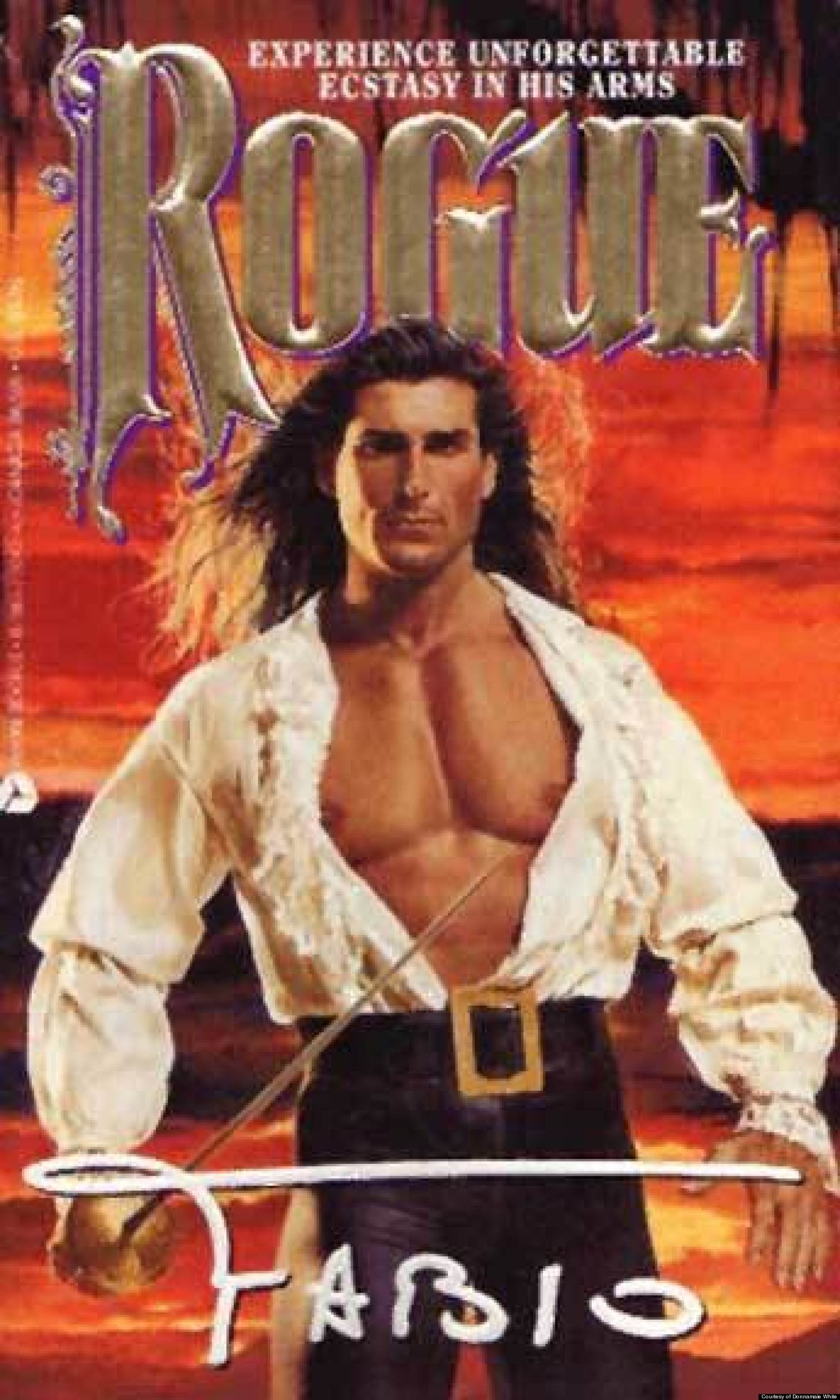 Or at least, it hardly ever happens on film. I’ve read a bunch of romance novels recently, and there the tropes are pretty consistently reversed. At least in the dozen or so books I’ve read, there is not a single instance of the character actor guy getting the incredible babe in the end. Instead, both men and women tend to be described as ravishingly attractive (and, in the case of men, as having impressive genital equipment. Size, in romance novels at least, does in fact matter.)
Or at least, it hardly ever happens on film. I’ve read a bunch of romance novels recently, and there the tropes are pretty consistently reversed. At least in the dozen or so books I’ve read, there is not a single instance of the character actor guy getting the incredible babe in the end. Instead, both men and women tend to be described as ravishingly attractive (and, in the case of men, as having impressive genital equipment. Size, in romance novels at least, does in fact matter.)




